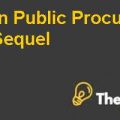
PROBLEM 2:
PART A: The landing fees of Turboprop currently represent 2.8% in the exhibit 1. If peak period landing will be 100 of Turboprop then the landing fee as % of revenue will increase to 3.3%. Similarly, if the peak period landing fee is 150 and 200 then the landing fee as % of revenue is 4.90% and 6.5% whereas regional jet and major airline currently represent 7% and 5.5% and as per peak period landing fee 100, 150, 200, landing fee as a % of revenue is less than the current landing fee percentage so this represent that peak period will have a significant impact on the Turboprop and there will not be such a significant impact on regional jet and major airline.
PART B: During the peak hours, delays depend upon the particular mix of airplane. If the mix is 40% of Turboprop then the landing percentage is high than the current landing percentage; hence, they may want to shift the operation at other times than the peak period. If the mix is 20% of Turboprop then there will be an equal effect on the demand.
PART C: Peak period is useful for high utilization of capacity and Lagon airport charged higher price during that period so that the runway demand run smoothly. If the demand increased from 50 planes then peak period price will reduce the demand by 28% as mentioned in the case but in case the demand remains at 50 planes then this change will not take place. In addition, peak period pricing is only useful on that type of plane which has higher demand that is conventional jets as the conventional jets represent the higher mix of 42% as compared to the other two planes. Therefore, if the demand is high, then the demand management may save some of the delay cost.
PROBLEM 3:
PART A: If arrival rate exceeds the service rate then huge queue of planes will be waiting as they need someplace where the planes can be diverted; otherwise they have to wait in the air that will result in huge delay cost.
PART B: Under the assumption that weekday peaking pattern resembles the 2000 then the delay time is 1.06875. The arrival capacity will be 22.5 if there are two runways available; however, the will be arrival capacity is 30 if there is one runway available. Moreover, operational and delay cost is also calculated for 19 seats, 150 seats along with regional jets of 50 seats and value of passengers.
RECOMMENDATIONS:
As far as Problem 1 is concerned, FAA’s definition does not seem reasonable and reducing the arrival rate during heavy demand will reduce scheduling cost as the demand will run smoothly and delay cost associated with the delay planes will be avoided.
As far as Problem 2 is concerned, the peak period landing fee of 100,150, 200 will have a significant impact as the new landing percentage will change and it will be higher from the current landing percentage.
Delay depends on the mix of the airplane so the 40% Turboprop will have a significant effect as the peak period landing percentage will increase; however, if the mix is 20% of Turboprop then there will be no impact.
There will be saving in the delay cost through the demand management offset peak period only if the demand increases and as per the case, demand will reduce by 28% that will save the delay cost.................................
This is just a sample partial case solution. Please place the order on the website to order your own originally done case solution.













